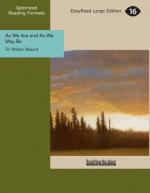’Here is a large property which has hitherto been devoted to the use of maintaining in idleness, and not as a reward or pension for good work done, a Master, three Brothers, three Sisters, and ten poor women. The ecclesiastical purposes for which the property was originally got together have long since utterly vanished. The church in which service used to be held is abolished, and the place where it stood is turned into a dock. We will build a new church where none is wanted, we will perpetuate the waste of all this money; the stipends of the Brothers and Sisters shall be raised; to the Brothers shall be assigned, nominally, the service in the chapel, but they shall have a chaplain or reader, to prevent this duty from becoming onerous; the Sisters shall have nothing at all to do; the Bedeswomen shall be deprived of their houses and shall receive no advance in their pay, but they shall be doubled in number. Twenty Bedesmen shall also be added with the same pay, viz., L10 a year, or 4s. a week.[NOTE: Note that in 1545 each Bedeswomen received 10d, a week, and each Sister 3s., so that the proportion of Bedeswoman’s pay to Sister’s pay was then as 1:3’6. But Lord Lyndhurst takes away the houses from the poor women and gives them no more pay, so that, without counting the loss of their houses, the Bedeswoman’s pay under Victoria is to the Sister’s pay as 1:19. The Victorian Bedeswoman was therefore relatively reduced in proportion to the Sister six-fold compared with her Tudor predecessor.] The Master shall have a beautiful house with a garden, conservancy, stabling for seven horses, and L1,200 a year, besides comfortable perquisites. He shall have no duties except the presidency of the chapter. And in order that the thing may not seem perfectly and profoundly ridiculous there shall be a school of twenty-four boys and twelve girls.’
This was the solution proposed and adopted by two eminent Chancellors, and carried into effect for thirty years. During the years 1858-1863 the average revenue was L7,460 8s. 2-3/4d. Of this sum the Master, Brethren, and Sisters absorbed with their buildings L4,102 8s. 2-3/4d.; the management expenses Were L909 5s. 6d.; the chapel cost L211 17s. 11d., sundries amounted to L141 6s. 10-3/4 d.; and the useful portion of the expenditure was represented by the sum of L554 9s. 7-1/2 d. Absolute uselessness—for the chapel was by no means wanted—is represented by L6,904, and usefulness by L554—a proportion of very nearly 12-1/2:1.
Yet another opportunity occurred of dealing rationally with this large property.
In the year 1871 a Royal Commission was appointed to examine ’into several matters relative to the Royal Hospital of St. Katherine near the Tower.’ The question might again have been raised how best to apply the large revenues for the general good. The Commissioners had before them quite clearly the way in which the seven thousand and odd pounds a year was being spent; they could arrive as easily as ourselves at the proportion above set forth, viz.:




